
Mahonia is a formerly accepted genus of approximately 70 species of shrubs or, rarely, small trees with evergreen leaves in the family Berberidaceae, native to eastern Asia, the Himalaya, North America, and Central America. They are closely related to the genus Berberis and as of 2023 the majority of botanical sources list it as a synonym for Berberis.

Cercocarpus, commonly known as mountain mahogany, is a small genus of at least nine species of nitrogen-fixing flowering plants in the rose family, Rosaceae. They are native to the western United States and northern Mexico, where they grow in chaparral and semidesert habitats and climates, often at high altitudes. Several are found in the California chaparral and woodlands ecoregion.

Amorpha is a genus of plants in the pea family, Fabaceae. All the species are native to North America, from southern Canada, most of the United States (US), and northern Mexico. They are commonly known as false indigo. The name Amorpha means "deformed" or "without form" in Greek and was given because flowers of this genus only have one petal, unlike the usual "pea-shaped" flowers of the Faboideae subfamily. Amorpha is missing the wing and keel petals.

Rudbeckia is a plant genus in the Asteraceae or composite family. Rudbeckia flowers feature a prominent, raised central disc in black, brown shades of green, and in-between tones, giving rise to their familiar common names of coneflowers and black-eyed-susans. All are native to North America, and many species are cultivated in gardens for their showy yellow or gold flower heads that bloom in mid to late summer.

Agathosma is a genus of about 140 species of flowering plants in the family Rutaceae, native to the southern part of Africa. Common names include buchu, boegoe, bucco, bookoo and diosma. Buchu formally denotes two herbal species, prized for their fragrance and medicinal use despite their toxicity. In colloquial use however, the term is applied to a wider set of fragrant shrubs or substitutes.
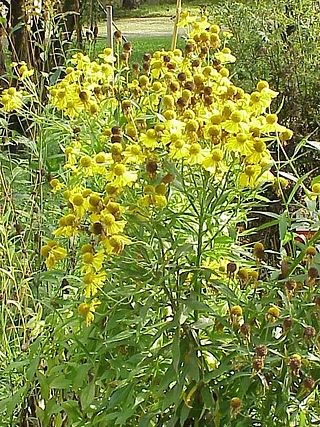
Helenium is a genus of annuals and herbaceous perennial plants in the family Asteraceae, native to the Americas.

Dillenia is a genus of flowering evergreen or semi-evergreen trees and shrubs in the family Dilleniaceae, native to tropical and subtropical regions of southern Asia, Australasia, and the Indian Ocean islands.

Heterotheca is a genus of North American plants in the family Asteraceae.

Balaka seemannii is a species of flowering plant in the family Arecaceae that is endemic to Fiji; growing in mixed forests on Vanua Levu and Taveuni islands.
Perebea is a genus of plant in family Moraceae.
Pseudolmedia is a flowering plant genus in the mulberry family (Moraceae). Species are found in southern Mexico, the Caribbean, and Meso- and South America. They are known in Latin America as lechechiva and used for timber, construction wood, and sometimes in folk medicine.
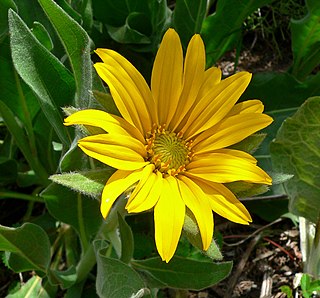
Wyethia is a genus of North American flowering plants in the family Asteraceae. First published by Thomas Nuttall in J. Acad. Nat. Sci. Philadelphia vol.7 on page 39 in 1834.
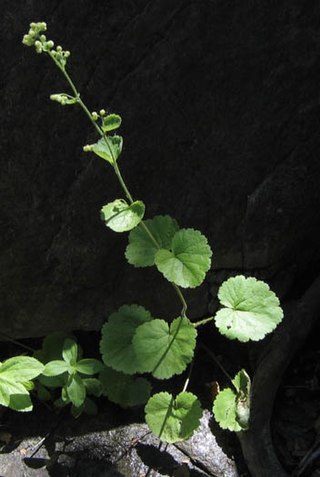
Boykinia rotundifolia is an uncommon species of flowering plant in the saxifrage family known by the common name roundleafed brookfoam. It is endemic to Southern California, where it grows in shady forested areas near streams in the mountains.
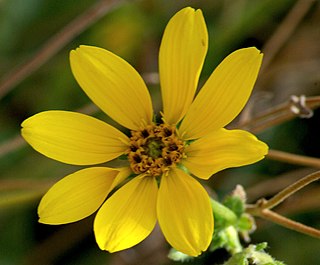
Engelmannia, or Engelmann's daisy, is a genus of North American flowering plants in the family Asteraceae.

Pityopsis is a genus of North American plants in the tribe Astereae within the family Asteraceae. Species of Pityopsis are known by the common names silkgrass or golden asters or grass-leaved goldenasters.
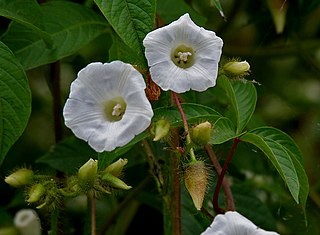
Merremia is a genus of flowering plants in the morning glory family, Convolvulaceae. Members of the genus are commonly known as woodroses.
Cyrtandra cleopatrae is a species of plant in the family Gesneriaceae endemic to the Philippines. It is a tropical shrub having recaulescent inflorescences composed of multiple purpled flowers that emerge on the plant stem from stubby shoots. It was first collected for science during a 1998 expedition sponsored by the Royal Botanic Garden Edinburgh, from a location in Palawan called Cleopatra's Needle (elev. 1550m), thus the specific epithet "cleopatrae". The taxon was first published in the Edinburgh Journal of Botany in 2001.
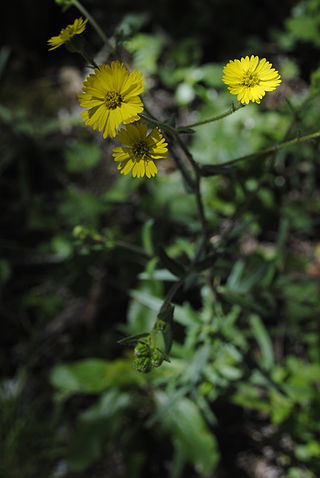
Anisocarpus is a genus of flowering plants in the tribe Madieae within the family Asteraceae.
Hypericum aciculare is a shrub in the genus Hypericum, in the section Brathys. It is an accepted name according to The Plant List and Tropicos.

Boykinia richardsonii is a species of flowering plant in the family Saxifragaceae, endemic to Alaska and the adjacent Canadian territory of Yukon. It is commonly known as Richardson's brookfoam, but has also been called Alaska boykin, bearflower, Richardson's boykin and Richardson's saxifrage. "Bearflower" reflects its popularity with grizzly bears as forage in the summer months when it flowers.
















